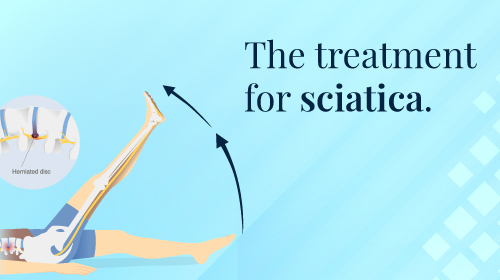How to Cure Sciatica Permanently
September 28, 2022

Pain that emits from the back of the thigh and down the lower leg is referred to as sciatica. It may be induced by the discomfort of one or more of the lower spinal nerves. The pain can be either mild or severe, frequently caused by wear and tear on the lower spine. The good news is that sciatica can usually be relieved conservatively within a few weeks without surgery. In addition, working to strengthen your back and core while increasing flexibility in your hips and lower body will substantially decrease the likelihood of having experienced lower back pain and other sciatica symptoms.
Symptoms
- Sciatica symptoms range from a minor ache to excruciating discomfort that radiates along the sciatic nerve pathway, which keeps running from your lower back straight down your hips and into each leg.
- Some symptoms include numbness, tingling, or muscle weakness that moves across the back of your thigh and into your calf or foot. It is frequently exacerbated by coughing or sneezing.
- Typically, people suffering from sciatica only have symptoms on one side of their body.
- Although the pain can be excruciating, sciatica can usually be relieved with physical therapy, chiropractic and massage treatments, increased strength and flexibility, and heat and ice packs.
Risk Factors
Many factors can predispose you to sciatica, which also impacts athletes and those who are less active.
- Sedentary individuals are more likely to develop sciatica than active individuals.
- Endurance athletes, on the other hand, are prone to sciatica due to overstressed and stiff muscles.
- Age is also a factor, as people between the ages of 30 and 60 are more likely to have age-related degeneration in their spine, such as herniated discs, bone spurs, and hip joint dysfunction.
- Diabetes and obesity are also significant contributors.
Improving the core and back strength
The musculature surrounding your spine and stomach may be weak or overly tight, preventing it from adequately supporting your body. Poor posture and weak muscles can disrupt your spine’s alignment, increasing your risk of lower back pain and sciatica. Softcore and back strengthening exercises will enhance your balance and ability to react to stress, lowering the chance and severity of severe back pain. While recovering from sciatica, avoid high-impact activities like running and plyometrics.
Increasing hip and hamstring flexibility
Stiff hamstrings, glutes, and hips can change your posture and put more strain on your lower back, contributing to sciatica. An elongating schedule that specifically targets the hips and hamstrings and helps relieve an overused or inflamed piriformis muscle will support most types of sciatica. The piriformis is a small muscle that runs just above the sciatic nerve and attaches to the base of the spine. Prolonged sitting or inactivity compresses the piriformis over the sciatic nerve, causing aggravation and pain. Reverse the consequences of tight hips and hamstrings by incorporating yoga or a simple stretching routine into your whole fitness regimen.
Here are two techniques for stretching your piriformis muscle and relieving pain.
Stretch 1
- Lie on your back, knees bent and feet flat on the ground.
- Raise one leg and cross it above the knee.
- Pull up to your chest on the thigh of the leg with the foot on the floor until you feel a stretch in your buttocks.
- Hold the position for ten to thirty seconds.
- Repeat on the other side.
Stretch 2
- Lie on your back with your legs outstretched.
- Pull one knee up and over to the opposite shoulder while holding one knee with your opposite hand.
- Hold the position for ten to thirty seconds.
- Repeat on the other side.
Diagnosis
A health care provider may check muscle strength and reflexes during a physical exam. For example, you might be asked to walk on your toes or heels, get out of a squat, and lift your legs one at a time while lying on your back. Unfortunately, sciatica pain usually worsens while performing these movements.
The tests that are conducted to diagnose sciatica include:
- X-Ray
- MRI
- CT-Scan
- Electromyography (EMG)
Treatment
Some of the following treatments may be useful for pain that does not improve with self-care measures.
Medications
The following medications may be used to treat sciatica pain:
- Anti-inflammatories
- Corticosteroids
- Antidepressants
- Medication to prevent seizures
- Opioids
Physical treatment
Once the pain has subsided, a health care provider can devise a programme to prevent future injuries. This usually includes exercises to improve posture, core strength, and range of motion.
Steroid injections
In some cases, injecting a corticosteroid medication into the area around the painful nerve root can help. A single injection can often help reduce pain. Three can be given in a single year.
Surgery
Surgeons can eliminate the bone spur or the herniated disc portion that is pressing on the nerve. However, surgery is typically reserved for cases where sciatica causes severe weakness, bowel or bladder control loss, or pain that does not improve with other treatments.
Home remedies
Exercising when you’re in pain may feel strange, but studies show that resting too much can exacerbate your back and leg symptoms. So instead, integrate mild exercise into your daily routine to alleviate sciatica. Gentle exercise is essential: it should not be hurtful or strenuous.
Make gentle stretching a part of your daily routine. Stretching is an excellent way to increase spinal flexibility and range of motion while strengthening your core and spinal muscles. Furthermore, most stretches are simple enough to do while watching the news or a movie.
If you remain in the exact position for an extended period, whether at your desk or home, your sciatica pain may worsen. Changing your pose every 20 minutes and practising proper posture can help relieve pressure on your spine and alleviate sciatica symptoms.
FAQ
1. What is the most successful treatment for sciatica?
Physical therapy and stretching are two of the most effective ways to treat sciatica pain and prevent it in the future. We can target and strengthen the muscle groups in your back with physical therapy to relieve pressure on your sciatic nerve.
2. What is the fastest way to cure sciatica?
Switching between heat and ice therapy can relieve sciatic nerve pain quickly. Heat promotes blood flow to the painful area, while ice reduces inflammation (speeds healing). Heat and ice may also help to relieve the painful muscle spasms that frequently accompany sciatica.
3. Can you fully recover from sciatica?
The incredible thing is that sciatica typically goes away by itself with time and some self-care treatment options. Most people with sciatica (80% to 90%) recover without surgery, and roughly half of these recover completely within six weeks.








